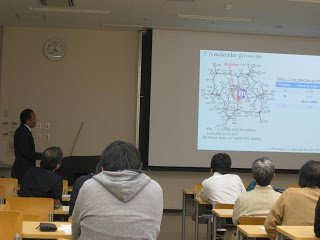

| Visitors Now: | |
| Total Visits: | |
| Total Stories: |
Our congratulation to Dr. Anant Marahatta
Monday, November 12, 2012 9:01
% of readers think this story is Fact. Add your two cents.
Anant Marahatta
successfully defended his PhD dissertation this month (2012, November) at Tohoku
University Sendai, Japan. We would like to
congratulate him for his achievement.
successfully defended his PhD dissertation this month (2012, November) at Tohoku
University Sendai, Japan. We would like to
congratulate him for his achievement.
His Ph.D. research work is mainly
concentrated on the “Theoretical investigation of the structures and dynamics
of the crystalline molecular gyroscopes”. His work is regarded as a complementary theoretical study that aimed to characterize
the experimentally synthesized crystalline molecular gyroscopes (It is a
compliment from the ACS reviewers). He computed series of quantum chemistry
calculations by applying Gaussian-03 and density-functional-based tight-binding
program (DFTB+) packages. Here is a short description of his research
work.
concentrated on the “Theoretical investigation of the structures and dynamics
of the crystalline molecular gyroscopes”. His work is regarded as a complementary theoretical study that aimed to characterize
the experimentally synthesized crystalline molecular gyroscopes (It is a
compliment from the ACS reviewers). He computed series of quantum chemistry
calculations by applying Gaussian-03 and density-functional-based tight-binding
program (DFTB+) packages. Here is a short description of his research
work.
The phenylene-bridged macrocages whose
interior rotator (phenylene) is protected by an exterior framework (stator) are
found to be structurally analogous with the macroscopic gyroscope and expected
to have many several useful collective effects and properties in the crystal such
as dichorism and birefringence. Recently, an X−ray crystallography of the
gyroscope like molecule having a phenylene rotator encased in three long
siloxaalkane spokes was reported by Prof. W. Setaka and his group. They
observed the phenylene rotator at three stable positions around the molecular
axis, suggesting the molecule demonstrates functions as a molecular gyroscope
in crystal. The rotational dynamics and the underlying mechanisms of such novel
molecular gyroscope were not revealed. I am the first to carry out series of
quantum chemistry calculations for theoretically investigating its crystal structures
and the rotational dynamics. Another objective of my research is finding
computationally cheap yet decent theoretical method that can characterize the
experimentally synthesized crystalline molecular Gyroscope.
interior rotator (phenylene) is protected by an exterior framework (stator) are
found to be structurally analogous with the macroscopic gyroscope and expected
to have many several useful collective effects and properties in the crystal such
as dichorism and birefringence. Recently, an X−ray crystallography of the
gyroscope like molecule having a phenylene rotator encased in three long
siloxaalkane spokes was reported by Prof. W. Setaka and his group. They
observed the phenylene rotator at three stable positions around the molecular
axis, suggesting the molecule demonstrates functions as a molecular gyroscope
in crystal. The rotational dynamics and the underlying mechanisms of such novel
molecular gyroscope were not revealed. I am the first to carry out series of
quantum chemistry calculations for theoretically investigating its crystal structures
and the rotational dynamics. Another objective of my research is finding
computationally cheap yet decent theoretical method that can characterize the
experimentally synthesized crystalline molecular Gyroscope.
The most important conclusion of this research work
is that in the presence of highly efficient encapsulating frame around the
rotating segment, the rotational dynamics of crystalline molecular gyroscopes
can be dramatically improved with an extremely low activation barrier. It is
very essential to realize the rotationally free molecular machines. I am able
to reveal the microscopic mechanisms of rotations with the help of reasonably
simple theoretical methods. It will be highly beneficial for the development of
nanoscale devices based on assemblies of molecular gyroscopes.
is that in the presence of highly efficient encapsulating frame around the
rotating segment, the rotational dynamics of crystalline molecular gyroscopes
can be dramatically improved with an extremely low activation barrier. It is
very essential to realize the rotationally free molecular machines. I am able
to reveal the microscopic mechanisms of rotations with the help of reasonably
simple theoretical methods. It will be highly beneficial for the development of
nanoscale devices based on assemblies of molecular gyroscopes.
He has started a post-doctoral position at the same University in Japan. We wish him a successful career ahead.
For
detail, you can go through my research paper:
detail, you can go through my research paper:
2012-11-12 08:42:28
Source: http://www.nepachemistry.com/2012/11/our-congratulation-to-dr-anant-marahatta.html
Source:




